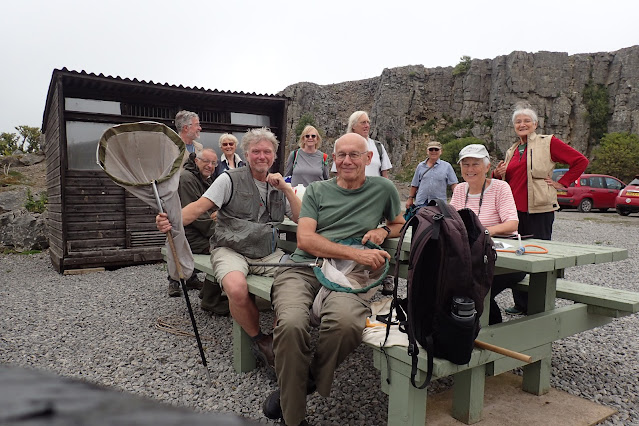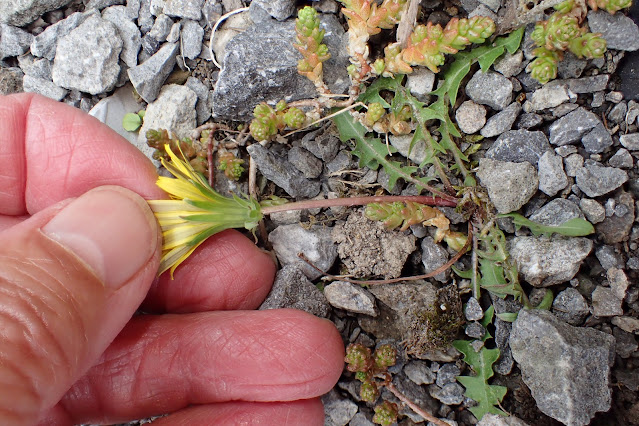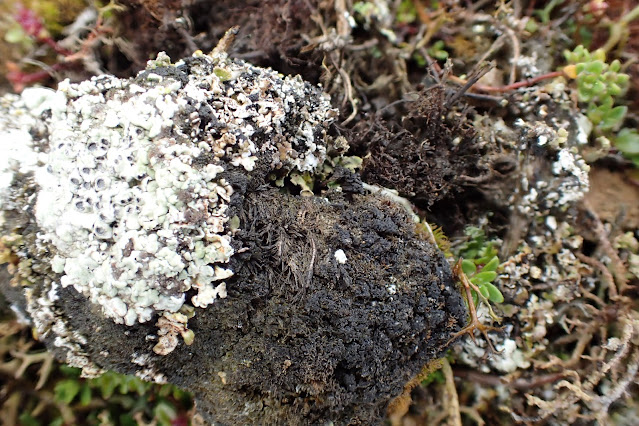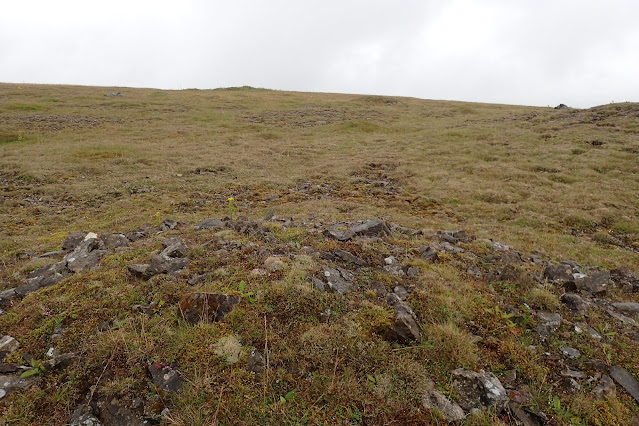 |
Seven spot ladybird examines
Rhizocarpon petraeum
|
Redmire Quarry is a large shelf high on the side of the valley of the river Ure (Wenseleydale, N Yorks) with SW facing limestone cliffs at 350m above sea level.
I especially enjoyed finding lichens on the led mine spoil heaps above the quarry. See lower down on the article.
We had special permission from Caslte Bolton Estate to visit the quarry.
Terry Whitaker was the organiser of the meeting and had also provided a stove and water so we could make tea, on the picnic table that is there by the private hut.
We arranged to meet up again at 2pm by this table
 |
| 11a.m. |
 |
My entomological contribution.
Derek saw two other species as well. |
. I spent so long making and drinking his tea when I first arrived that I missed going to see the final moth traps being opened. Apparently they had an excellent catch. At least six people had come from Yoredale Natural History Society.
The moth trappers had departed and the rest of us sat for a photoshoot at 11am before setting off as a group.
There was a "Limestone Dandelion" and lots of Limestone Bedstraw.
 |
| "Limestone Dandelion" the lowest involucral bracts stick out. |
 |
| Limestone Bedstraw |
Other people saw the beautiful blue Viper's Bugloss (Anyone from the trip want to send me a picture?)
Gaby released some of the special moths they had captured.

 |
Northern Eggar Moth (= Oak Eggar Moth) on Gaby's boot
|
 |
| Northern Eggar Moth (= Oak eggar Moth) |
|
 |
| Tiger Moth |
 |
| The first and only bit of Knotted Pearlwort Sagina nodosa (it has white anthers) in a slight rain gully on the track on the way up. |
---------------------------------
A platform along the length top of the cliffs has pebbles and mounds and evidence of lead mines. It is bordered by rabbit proof fencing and beyond that the land, now gritstone with heather and limestone without, rises with remains of lead mines and grouse moor.
 |
The first of many Spring Sandwort plants.
Spring Sandwort has pink anthers. |
I spent much of the time on this rabbit grazed platform. It had short vegetation - in fact mostly moss and lichens:
I had carefully collected a sliver of rock with Rhizocarpon petraeum from the cliff on the way up .....
 |
| Rhizocarpon petraeum on the cliff face |
 |
| Distribution map from the BLS website |
... only to discover that this bright white crustose lichen with its concentric rings of black apothecia was super-common on the piles of pebbles on the platform above.
 |
| View back down to the picnic table and cars |
 |
Cetraria aculeata
|
 |
The Cladonia rangiferina seemed
to occur in all sorts of shapes and forms.
Here it has wide flattened podetia. |
 |
| The Cladonia rangiferina |
 |
| Not sure what this white Cladonia is. |
 |
| Moonwort |
On the top, Big Shaggy-moss - the official name of Hylocomiadelphus triquetrus (formerly Rhytidiadelphus triquetrus) was the dominant vegetation, closely followed by Cladonia rangiformis (My name: Limestone Giraffe Lichen): Both of these were pale pastel green in the grey light of cloudy midmorning which preceded the drizzle of 1p.m.
Then my eyes picked out the dark glossy brown tangles of wire-netting-like Cetraria aculeata. I could not find any of its relation C. muricata though I looked hard.
Green mounds 12cm in diameter of a cushion moss (Tortula tortuosa?) had dead summits on the mounds which were covered in black stuff. Was this a result of the drought 6 weeks earlier - or was this the result of a lichen? Many of these black areas had a rough textured thick white crustose lichen with tiny urn shaped apothecia - Diploschistes muscorum . I am used to seeing this on moss on limestone walls where Cladonia pocillum grows. A glance at Dobson's book says it also grows on C rangiformis - well plenty of that here.

| Diploschistes muscorum growing on black stuff on Cushion Moss Note C rangiformis in the foregrounds |
 |
| Closer up. |
 |
Diploschistes muscorum growing on black stuff on Cushion Moss
|
|

Thyme and Sheep's-fescue grass were the main higher plants.
 |
| Moonwort |
 |
| Rabbit tunnel |
 |
| Left side: quarry side; right side: moorland side |
 |
| A strange lumpy form of Cladonia rangiformis |
 |
| Peltigera |
 |
| A pool full of Water Speaerwort. |
 |
| i lost my handlens / penknife. I retraced my steps and found it. What a relief |
 |
| Definite evidence of rabbits |
I had also lost everyone else by now. I spent a long time enjoying this new habitat for me. I wondered if a real lichen expert would notice more species than I was noticing, but ended up walking over lots more of the only the same species. Only one Peltigera (Dog Lichen).
I found one moonwort shoot in SE048929 and two moonwort shoots close to each other in SE048930 in another.
We had arranged to meet up again at 2pm by this table.. and had lunch. Well prepared with umbrellas.
 |
| 2pm. Well prepared for the rain |
I climbed up the mound (and island of bedrock) behind the picnic table and found surface vegetation similar to the top platform of the quarry - and also some beautiful yellow Hygrocybe. (waxcaps) with slimy caps.
 |
| Hygrocybe. Some had slightly reddish streaked stipes (like H puniceus) and others had stipes which were smoother and just yellow and white |
 |
Yellow Hygrocybe Waxcaps amongst the
Thyme and Big Shaggy-Moss |
Back at the Village Hall early we had tea, the roll call of Societies and the plenary session. Then we repeated part of the plenary and had more tea when several more members turned up at the official time of 4pm. It was good to meet old and new friends.









































No comments:
Post a Comment